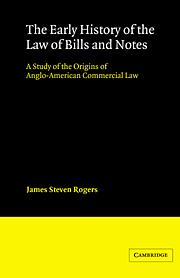 The Early History of the Law of Bills and Notes
The Early History of the Law of Bills and Notes Book contents
- Frontmatter
- Contents
- Preface
- Table of cases and precedents
- Note on citation
- Introduction
- 1 The central courts, commercial law, and the law merchant
- 2 Early exchange transactions: commercial practice
- 3 Early exchange transactions: private law
- 4 Early exchange transactions: public law and policy
- 5 From exchange transactions to bills of exchange: the transformation of commercial practice
- 6 The custom of merchants and the development of the law of bills
- 7 The civilians and the law of bills in the seventeenth century
- 8 Transferability and negotiability
- 9 The law of bills and notes in the eighteenth century
- 10 The problem of accommodation bills
- Conclusion
- Bibliography
- Index
8 - Transferability and negotiability
Published online by Cambridge University Press: 22 September 2009
- Frontmatter
- Contents
- Preface
- Table of cases and precedents
- Note on citation
- Introduction
- 1 The central courts, commercial law, and the law merchant
- 2 Early exchange transactions: commercial practice
- 3 Early exchange transactions: private law
- 4 Early exchange transactions: public law and policy
- 5 From exchange transactions to bills of exchange: the transformation of commercial practice
- 6 The custom of merchants and the development of the law of bills
- 7 The civilians and the law of bills in the seventeenth century
- 8 Transferability and negotiability
- 9 The law of bills and notes in the eighteenth century
- 10 The problem of accommodation bills
- Conclusion
- Bibliography
- Index
Summary
In the previous chapters, little attention has been devoted to a subject that is commonly taken to be the main point of interest in the history of the law of bills and notes, the development of the principle of negotiability. This omission is quite intentional. One of the premises of this book is that a major flaw in the traditional accounts of the development of the law of bills and notes is the preoccupation with the concept of negotiability. This chapter attempts to place this issue in proper perspective by examining the issues concerning the transfer of bills and notes that were and were not matters of real concern in the seventeenth and eighteenth centuries.
TRANSFERABILITY
Indorsement
Precisely how and when the practice of indorsing bills developed is not entirely clear, even though the point has probably attracted far greater attention from legal and economic historians than it truly warrants. Historians of continental business practice have found isolated instances of indorsed bills dating from the early sixteenth century, but it is generally thought that the practice did not become common on the continent until after 1600. Evidence on English practice suggests a similar date.
Contrary to the usual view that the main theme of the early history of the law of bills was the struggle against the common law principle that choses in action are not assignable, the practice of transferring bills seems to have been accommodated by the common law courts with relatively little difficulty.
- Type
- Chapter
- Information
- The Early History of the Law of Bills and NotesA Study of the Origins of Anglo-American Commercial Law, pp. 170 - 193Publisher: Cambridge University PressPrint publication year: 1995
